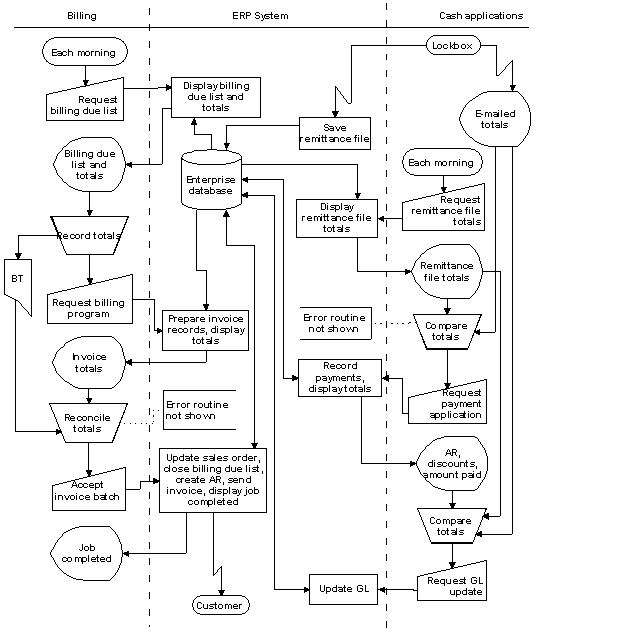Data processing system
A data processing system is a combination of machines, people, and processes that for a set of inputs produces a defined set of outputs.[1] The inputs and outputs are interpreted as data, facts, information, ... depending on the interpreter's relation to the system. A common synonymous term is "information system".[2]
A data processing system may involve some combination of:
- Conversion converting data to another format.
- Validation – Ensuring that supplied data is "clean, correct and useful."
- Sorting – "arranging items in some sequence and/or in different sets."
- Summarization – reducing detail data to its main points.
- Aggregation – combining multiple pieces of data.
- Analysis – the "collection, organization, analysis, interpretation and presentation of data.".
- Reporting – list detail or summary data or computed information.
Types of data processing systems
By application area
Scientific data processing
Scientific data processing "usually involves a great deal of computation (arithmetic and comparison operations) upon a relatively small amount of input data, resulting in a small volume of output." [3]
Commercial data processing
Commercial data processing "involves a large volume of input data, relatively few computational operations, and a large volume of output."[3] Accounting programs are the prototypical examples of data processing applications. Information systems (IS) is the field that studies such organizational computer systems.
Data analysis
"Data analysis is a body of methods that help to describe facts, detect patterns, develop explanations, and test hypotheses."[4] For example, data analysis might be used to look at sales and customer data to "identify connections between products to allow for cross selling campaigns."[5]
By service type[2]
- Transaction processing systems
- Information storage and retrieval systems
- Command and control systems
- Computing service systems
- Process control systems
- Message switching systems
Examples
Simple example
A very simple example of a data processing system is the process of maintaining a check register. Transactions— checks and deposits— are recorded as they occur and the transactions are summarized to determine a current balance. Monthly the data recorded in the register is reconciled with a hopefully identical list of transactions processed by the bank.
A more sophisticated record keeping system might further identify the transactions— for example deposits by source or checks by type, such as charitable contributions. This information might be used to obtain information like the total of all contributions for the year.
The important thing about this example is that it is a system, in which, all transactions are recorded consistently, and the same method of bank reconciliation is used each time.
Real-world example
This is a flowchart of a data processing system combining manual and computerized processing to handle accounts receivable, billing, and general ledger
References
- ↑ The first machines used for data processing were punched card machines, now Computers are used.
- 1 2 Anthony Ralston et al (ed.) (2000). Encyclopedia of Computer Science 4th ed. Nature Publishing Group. p. 865.
- 1 2 Reddy, R.J. (2004). Business Data Processing & Computer Applications. New Dehli: A P H Publishing Corporation. p. 17. ISBN 8176486493.
- ↑ Dartmouth College. "Introduction: What Is Data Analysis?" (PDF). Retrieved July 5, 2013.
- ↑ Berthold, M.R.; Borgelt, C; Hőppner, F.; Klawonn, F (2010). Guide to Intelligent Data Analysis. Springer. p. 15. ISBN 978-1-84882-260-3.
- ↑ the highest acceleration of data processing the point of software
See also
- Data processing
- Electronic data processing
- Scientific computing
- Information processing system (broader term)
Further reading
- Bourque, Linda B.; Clark, Virginia A. (1992) Processing Data: The Survey Example. (Quantitative Applications in the Social Sciences, no. 07-085). Sage Publications. ISBN 0-8039-4741-0
